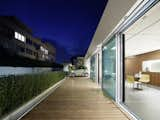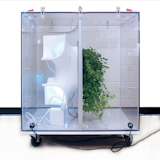More than 4,000 people have visited the home since it was constructed last fall. The home's exterior is actually a fabric skin you can touch, a better physical experience than plaster, and part of the architect's vision for more comfortable living. "How does the building smell, is there temperature distribution all over the building, does the air flow?" he says. "We need to design the tactile parts of a building, too."
A self-learning heating and power system inside the home utilizes a series of radio sensors inside and outside, as well as on the home's electric cars, to constantly compare and learn, not only adjusting to temperature differences and behavioral patterns but forecasting them. If it's going to be warm tomorrow, the home will anticipate when to stop heating the home and divert the overflow to the Le Corbusier building. Researchers at the University of Stuttgart studying the home have nearly nine months of data to work on, and after a family begins living in the home this spring, they'll be able to improve the system's performance with real-world data.
While architect Werner Sobek chose the name "active house," a contrast to the passive house philosophy of efficency and conservation, the incredible energy production achieved by the B10 wouldn't be possible without a next-level envelope. Utilizing opaque surfaces and a vacuum-insulated, frameless glass front, the model home achieves a super-tight seal; the terrace even folds up to completely shield the home from sun when residents are gone. "When we started building these research homes in 2000, we were making passive homes, but have always wanted to get around the limits of small windows and lots of insulation and make something active," says Sobek. The home is outfitted with Knoll furniture and kitchen furnishings by Leicht Küchen and Hansgrohe.
This flexible prototype, which can be subdivided with partitions for a more defined floor plan, will be a model for further developments, according to Sobek. He wants to bring these advances to taller, six- or eight-story structures and reduce the time it takes to install this prefab home from 24 to 18 hours, creating plug and play technology that can be a boon for future urban development. "As urban centers become more and more dense, these prefabricated units make more and more sense," he says. "They're light, require no workers on site or stir up any dust. Within the next 12 months, we will see several variations and the next generation of B10."
When Pablo Pérez Palacios’ Mexico City–based architecture firm PPAA was tasked with building an apartment tower to meet La Colonia Roma's need for additional housing, he faced a problem familiar to developers in historic neighborhoods everywhere. The site was occupied by a dilapidated home that dates to 1925, and local laws required that the facade and part of the structure be maintained. PPAA’s innovative approach was to cut the original three-story home in half, preserving enough of the building to front the street and hold two apartments replete with classic Victorian details like high ceilings and restored millwork. In the back of the lot, they designed a sleek eight-story apartment tower that would hold an additional nine apartments, for a total of 11 units. Not bad for a site that was previously an uninhabited single-family house.
"This is a prototype module of the Active Modular Phytoremediation Wall System, or AMPS, created by the Center for Architecture Science and Ecology. CASE combines the forces of SOM and Rensselaer Polytechnic Institute to align buildings more closely with nature, and to that end, AMPS capitalizes on plants' ability to clean the air that circulates inside them. By channeling stale air across plants’ best air-purification mechanisms, AMPS reduces buildings’ need to pump in fresh air from outdoors. This invention grows out of NASA research concerning the health of astronaut, and will touch down in the SOM-designed Public Safety Answering Center II call facility in the Bronx later this year."
For an escape from bustling San Francisco, architect Craig Steely and his wife Cathy have created a modernist getaway on a lava field next to a black sand beach on Hawaii’s Big Island. Fitted with floor-to-ceiling windows that look out over the ocean, the steel-framed home is one of several homes that Steely built on the recently active lava field.
Church at St. John’s Abbey (Collegeville, Minnesota, 1961)
In 1950, Abbot Baldwin Dworschak solicited forward-thinking designs from leading architects to remake his Minnesota church and create a monument to the service of God. Breuer answered the call. There's a certain majesty to the bell tower greeting the faithful, a massive panel supported by a curvaceous stand. That Breuer then follows it up with the church itself, with a massive wall of hexagonal stained glass and concrete tresses, makes this a classic.
Photo Credit: Wikimedia Commons
1,256 more photos



































